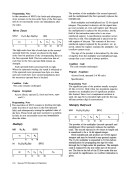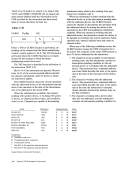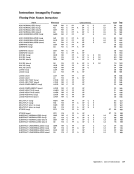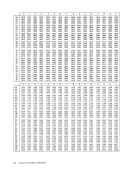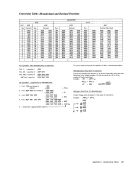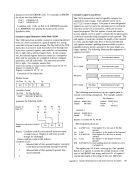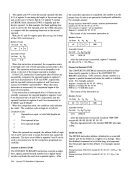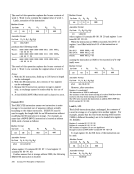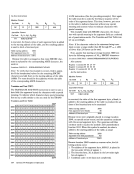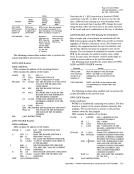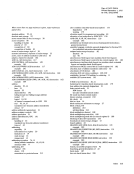The value of the timer is accessible by fetching
the word at location80 as an operand, provided the
location is not protected against fetching. The 32-bit
timer value may be changed at any time by storing a
new value at location80. When location 80 is pro
tected, any attempt to change the value of the timer
causes a program interruption for protection excep
tion.When protection exception is indicated, the
timer value remains unchanged.
The value of the timer may be changed without
losing the real-time count by loading the new value
in byte locations 84-87 and then shifting bytes80- 87 into byte locations 76-83 by means of the in
structionMOVE (MVC), thus placing in a single
operation the new timer value into word location80 and making the old value available at location 76.
TheMVC instruction may designate locations 76-87
by real addresses 76-87 or by any logical addresses
that translate to real addresses 76-87.
When the contents of the timer are fetched by
anotherCPU or by a channel or are used as a source
of an instruction, the result is unpredictable. Similar
ly, storing by the channel or by anotherCPU at loca
tion80 causes the contents of the timer to be unpre
dictable.
The timer value is not decremented when theCPU is not in the operating state, or when the rate
switch0111 the system console is set to the
instruction-step position.
Programming Notes
Theinterval timer, in association with a program,
can serve both as a real-time clock and as an interval
timer.
If any means other than the instructionMOVE (MVC) are used to interrogate and then replace the
value of the timer, includingMOVE LONG or two
separate instructions, the program may lose a time
increment if an updating cycle occurs between fetch
ing and storing.
When the value of the interval timer is to be re
corded on an110 device, the program should first
store the timer value in a temporary storage location
to which the110 operation subsequently refers.
When the channel fetches the timer value directly
from location80, the value obtained is unpredicta
ble.
Externally Initiated Functions
Resets
Two types ofCPU-reset functions are provided: CPU reset and initial CPU reset. By combining the
twoCPU-reset functions with the I/O-system-reset
function and clearing of storage, the following three
system resets are provided: program reset, initial
program reset, and system-clear reset. The table"Manual Initiation of System Resets" at the end of
the description of resets summarizes how each type
of system reset is manually initiated.Power-on reset
is performed as part of powering on.CPU reset provides a means of clearing
equipment-check indications and the resultant un
predictability, if any, in theCPU state with the least
amount of information destroyed. It is intended in
particular for clearing check conditions when the
system state is to be preserved for analysis or re
sumption of the operation.
InitialCPU reset performs the same functions as CPU reset but additionally initializes the contents of
control fields. In particular, it initializes the prefix
and control registers, which is normally necessary for
initial program loading.
Function PerformedOn 1
Position ofEnable- CPU on Which Key Was Other CPUs Configured for
Propagation ofManual Reset Key Activated System-Clear Key Activated System reset • Without store-status facility Normal Initial-program reset • With store-status facility Normal Program reset Program reset System reset Clf!ar System-clear reset System-clear reset
LoadNormal I nitial-program reset, followed Program reset
byIPL Load Clear System-clear reset, followed System-clear reset
byIPL Explanation: * This situation cannot occur, since the store-status facility is provided in a CPU equipped for multiprocessing.
1 Activation of the system-reset orload key may change the configuration, including the connection with channels, storage units,
and other CPUs.
Manual Initiation ofSystem Resets 50 System/370 Principles of Operation
the word at location
location is not protected against fetching. The 32-bit
timer value may be changed at any time by storing a
new value at location
tected, any attempt to change the value of the timer
causes a program interruption for protection excep
tion.
timer value remains unchanged.
The value of the timer may be changed without
losing the real-time count by loading the new value
in byte locations 84-87 and then shifting bytes
struction
operation the new timer value into word location
The
by real addresses 76-87 or by any logical addresses
that translate to real addresses 76-87.
When the contents of the timer are fetched by
another
of an instruction, the result is unpredictable. Similar
ly, storing by the channel or by another
tion
dictable.
The timer value is not decremented when the
switch
instruction-step position.
Programming Notes
The
can serve both as a real-time clock and as an interval
timer.
If any means other than the instruction
value of the timer, including
separate instructions, the program may lose a time
increment if an updating cycle occurs between fetch
ing and storing.
When the value of the interval timer is to be re
corded on an
store the timer value in a temporary storage location
to which the
When the channel fetches the timer value directly
from location
ble.
Externally Initiated Functions
Resets
Two types of
two
function and clearing of storage, the following three
system resets are provided: program reset, initial
program reset, and system-clear reset. The table
the description of resets summarizes how each type
of system reset is manually initiated.
is performed as part of powering on.
equipment-check indications and the resultant un
predictability, if any, in the
amount of information destroyed. It is intended in
particular for clearing check conditions when the
system state is to be preserved for analysis or re
sumption of the operation.
Initial
control fields. In particular, it initializes the prefix
and control registers, which is normally necessary for
initial program loading.
Function Performed
Position of
Propagation of
Load
by
by
1 Activation of the system-reset or
and other CPUs.
Manual Initiation of









































































































































